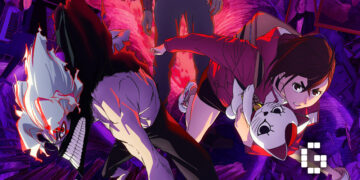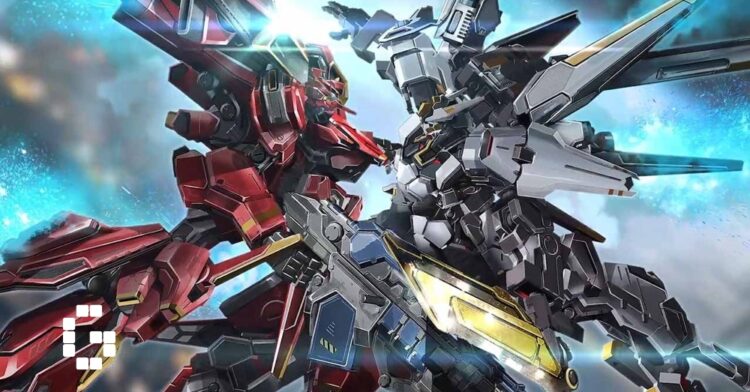Starting as Project Stella, and going through development hell, Kadokawa Games has finally released their new RPG strategy game, Relayer. Developed by the team behind the God Wars franchise, the game carries the “New Age Space Opera” mecha theme with gameplay that fans of Super Robot Wars and similar franchises will immediately feel familiar with.
Regardless of its status as a new IP, who would have thought if Kadokawa immediately targeted the global version released simultaneously, including an English dub option. They clearly want to make Relayer a game that can be immediately recognized by many gamers around the world. So does Relayer live up to these expectations? Well, it has a few kinks in its mech armor but I’d say it has a lot of potential.
Storyline
The game takes place in the year 2049, an important period when humanity encounters an ancient alien civilization called the Relayer who intends to destroy the universe and cause a Gravity Loss disaster on Earth. The disaster results in many buildings and people being sucked into space. The main character Terra is one such victim of the disaster, losing her sister Luna and all of her memories before the tragedy.

Two years have passed since the tragedy, now Terra, who lives his life as a traveler, finds Luna is still alive. This might be a touching reunion, but Luna has become part of the Relayer squad, wanting to take revenge on humanity, and has stolen the Original One, the first mechanoid robot made by the Relayer and was used as a template for humanity’s mechs when it crashed into Antarctica.
Terra, who was accidentally dragged into these events, meets a mech pilot named Himiko, a talented Starchild from GT Lab who then invites her to join the Asterism squad to reclaim the Original One and fight the Relayers. Terra decides she will bring her sister back and defend the Earth from the relayers.

There’s actually a lot going on throughout the plot. Terra’s personal story to save her sister, the secrets of dark forces who want to destroy the universe, the power of the Original One, and also stories from the point of view of several other factions such as the military industry and space pirates. The fact that the developers are able to balance all of this and connect it in one big story is commendable, as it really makes the whole plot is much richer and not just focused on one character.
Even so, there were some inconsistencies with the writing. For example, some characters make jokes or cheerful expressions in the middle of serious or tragic situations. There’s also the fact that a character who “betrayed” GT Lab by handing the Original One over to the Relayer is still welcome back into Asterism, when they really should be transported off to space jail.

Speaking of characters, there are quite a few that you will meet in the game, especially the troops that fight alongside Terra in Asterism. Most of them are basic stereotypes but the big exception to this is Himiko, who manages to be the badass warrior of the group while still being super chilled and friendly. She was just fun to be around, like a real-life co-worker.
Tactical RPG Gameplay with Few Twists
The combat system offers tactical gameplay that is easy to understand, especially if you are already familiar with the genre. Before starting each battle, you are given several options to prepare yourself such as changing equipment and unit positions. In battle, you can control each unit by selecting several options from the Command menu such as Attack, Skill, Item, Defend, and Standby (this is especially useless as you can always use Defend when positioning units without SP cost).

The main key in combat is to always use the Stellar Gear that is best suited against a certain type of enemy. There are four different types of mecha in the game, namely Assault, Sniper, Tank, and Scout. Here is a brief description of each type:
- Assault: An active fighter on the front line who relies on a two-handed sword weapon. There’s nothing really special about it other than the fact that they can do massive damage, but in some moments they can anticipate enemy attacks without getting hit while launching super-strong counterattacks (as long as the enemy is still an Assault and Tank type).
- Sniper: Midfield fighter armed with a ranged rifle for maximum damage. If lucky, sometimes Sniper can launch Overkill which is a one-hit kill attack, regardless of how much HP the enemy has.
- Tanks: Tanks are a very good type, they can fill the role of bait to attract enemy aggro while dealing solid damage. A very strong type and you must pair it on the front row with Assault. Not to mention that you can launch Backstab, a special attack that involves the roles of Assault and Tank that must lock the enemy from the front and back to launch a follow-up attack.
- Scouts: They’re not that great in combat and are more of a support unit, but there was a battle where we were able to take down 5 enemies solo using just Mercury. Because of that, we think Scout could be a pretty potential alternative DPS.
After knowing the differences between each type of Stellar Gear, you need to know how to attack effectively without being hit by a counterattack. Counterattacks can occur when you pit Sniper against Sniper, where the enemy will always counterattack because both units are fighting from a distance, so the right way to handle each encounter is to attack the Assault or Tank type with the Sniper and vice versa.

Each unit also has Physical and Gravity attributes, where the damage given when attacking is determined by the attributes of each weapon you are using (Yellow is Physical and Purple is Gravity). This scheme should be very important for maximizing your battle tactics, but we ended up not really paying attention to it because there is almost no difference in terms of damage potential.

Overall, this game has a pretty good depth of combat system but is a little too simple at the same time. We think the most surprising part is the Turn Order design where characters have to attack in a set order based on each character’s AGI stat. It felt unnecessarily limiting for a strategy game and I would have preferred being able to set units in any order.
The best part of the gameplay for us is the epic cutscenes of each battle. All the attack animations look really cool, smooth, and packaged in good choreography. The impression may not be as crazy as in Super Robot Wars games which sometimes seem to be supported by special transformations and plot armor, but the battle scenes in Relayer feel purer because each unit is only equipped with experience and weapons that have been set from the start. The design of each map also looks stunning and feels like placing yourself in outer space, which of course makes each battle feel a lot more immersive.
Customization and Side Content
Customization in Relayer includes the option to change Weapons, Shields, Armor, and Custom Chips to maximize the stats of each unit. You can buy all the equipment in the shop you enter the intermission section before starting the mission, including the additional option to upgrade lower-class weapons so that they can be turned into completely new weapons. This can be very useful so you don’t have to throw away old weapons just to buy new ones.

Increasing the level of each unit is very important, but you should always upgrade their equipment and skills as long as there is a chance because the difference in the difficulty level of each mission can be quite large. Not to mention that your units can only level up by performing special actions and don’t die until the end of the battle, so having one or two units weaker than the others can be quite natural.

Apart from strengthening your units, there is also a Job system called Star Cube and it gives access to 5 different potential jobs for each type of mecha. To reach a higher job, you must unlock all perks in the skill tree from the first job using JP (simply skill points). Each unit will always be given a considerable amount of JP at the end of each mission, so make sure to always check the Star Cube regularly, especially when you know that there are various perks and important skills that you can access from it.

In addition, every time you are in intermission you can relax by visiting various facilities such as the Asterism ship and interacting with the characters to get to know them better. There’s also the Space Science Library which is basically a huge glossary to check back on the story recaps, character profiles, weapon descriptions, viewer models for each mecha.
Conclusion
Relayer managed to hold my attention throughout the entire game thanks to its interesting storyline and strong characters. The game is not too comfortable following one conflict but tries to give a wider picture of the world setting which is full of conflicts from various factions with different motivations. All of this adds to the mysteries of its’ world, such as the secret of Terra’s past and, the reason behind his sister’s strong hatred of humans.
Unfortunately, our impressions on the combat part are quite mixed, especially because of how the system can feel so simple and the turn order design is more suited to a pure turn-based game. Leaving that part aside, the developer managed to present the battle segment with slick 3D animation without compromising the quality of the graphics.
If you’re a fan of mecha games and anime, this is a game to look out for.
| Pros | Cons |
| Surprisingly enjoyable story | Hard difficulty is still too easy |
| Combat is really easy to get used to | Some inconsistencies with the story bits (mainly character interactions) |
| Solid customization system | Turn Order feels to limiting |
 Relayer itself is planned to be released globally on March 24, 2022 tomorrow, exclusively for PlayStation 4 and PlayStation 5.
Relayer itself is planned to be released globally on March 24, 2022 tomorrow, exclusively for PlayStation 4 and PlayStation 5.












![[LEVEL UP KL 24] From Development to Quality Assurance: How AI is Transforming the Gaming Industry, According to Microsoft’s Jun Shimoda](https://cdn.gamerbraves.com/2024/12/Jun-Shimoda_Interview_FI-360x180.jpg)







![[CF 2024] Comic Fiesta 2024 Brings ACG Paradise to Malaysia](https://cdn.gamerbraves.com/2024/12/Comic-Fiesta-Overview_Feature_FI-350x250.jpg)
![[CF 2024] Hong Kong Comics Makes Strong Return to Comic Fiesta 2024 Following Opening Ceremony](https://cdn.gamerbraves.com/2024/12/Hong-Kong-Comics-Opening_News_FI-350x250.jpg)




